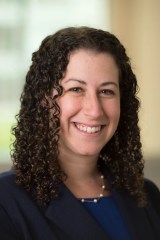
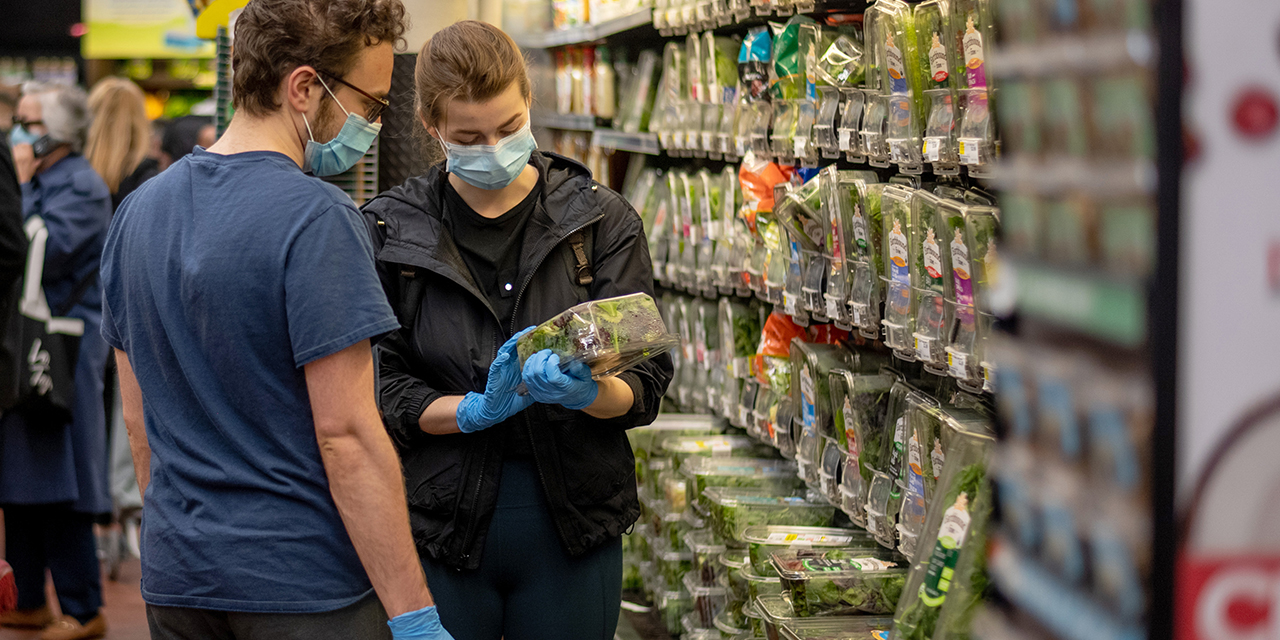
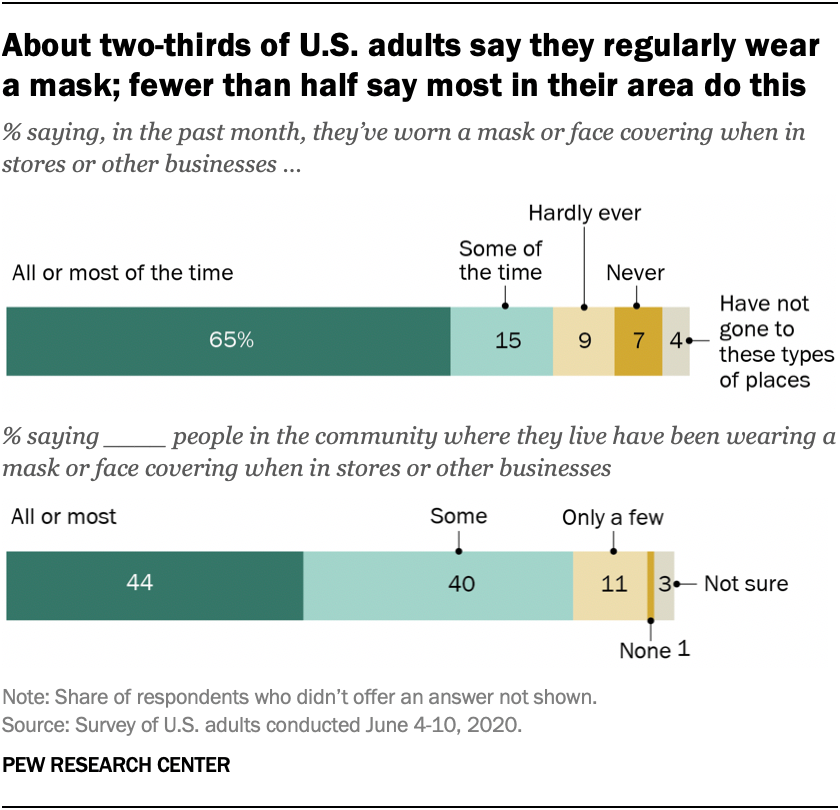
As states across the country take steps toward reopening, public health authorities have emphasized the importance of wearing masks inside stores or other enclosed spaces as a precaution against COVID-19. A majority of Americans report they have followed this guidance all or most of the time in the past month; fewer say all or most of the people in their communities are wearing masks in similar settings, according to a Pew Research Center survey conducted June 4-10, 2020.
Overall, 65% of U.S. adults say that they have personally worn a mask in stores or other businesses all or most of the time in the past month, while 15% say they did this some of the time. Relatively small shares of adults say they hardly ever (9%) or never (7%) wore a mask in the past month, and 4% say they have not gone to these types of places.
Americans in counties with more reported deaths from the coronavirus when adjusted for population are much more likely to say they wore a mask all or most of the time in stores or other businesses in the past month than those in counties where the death rate can be classified as more moderate or low (80% in high-impact counties, compared with 67% in medium- and 55% in low-impact counties).
How we did this
Pew Research Center conducted this study to understand Americans’ personal mask-wearing behavior and the mask-wearing behavior they observe in their communities, during the nationwide coronavirus outbreak. This analysis is based on 9,654 U.S. adults. The data was collected as a part of a larger survey conducted June 4-10, 2020. Everyone who took part is a member of Pew Research Center’s American Trends Panel (ATP), an online survey panel that is recruited through national, random sampling of residential addresses. This way nearly all U.S. adults have a chance of selection. The survey is weighted to be representative of the U.S. adult population by gender, race, ethnicity, partisan affiliation, education and other categories. Read more about the ATP’s methodology.
Here are the questions used for this report, along with responses, and its methodology.
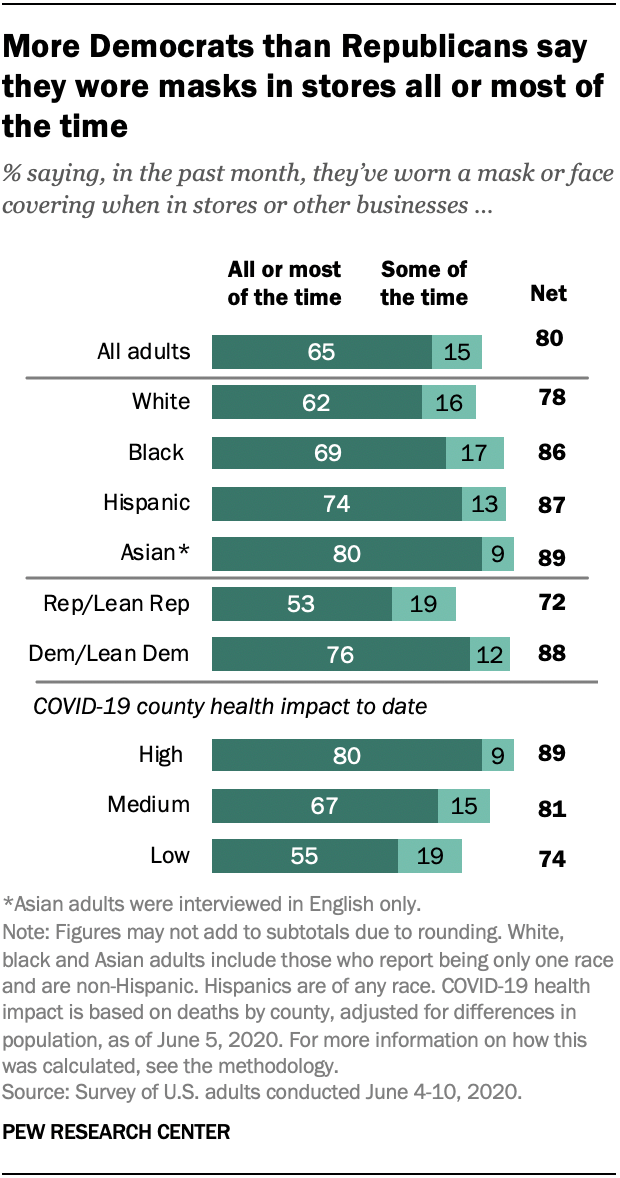
In recent months, mask-wearing has become a partisan issue. This partisan divide is also found in the behaviors of the general public: Democrats and those who lean Democratic are more likely than Republicans and Republican leaners to say they personally wore a mask all or most of the time in the past month (76% vs. 53%). Even after controlling for differences in the COVID-19 health impact in the communities where people live, Democrats are more likely to say they personally wear a mask all or most of the time.
Conservative Republicans are among the least likely to say they have worn a mask all or most of the time in the past month – 49% say they’ve done so, compared with 60% of moderate Republicans. Liberal Democrats are the most likely to say they have worn masks (83% say they’ve done so all or most of the time, vs. 71% of moderate Democrats).
There are also differences across racial and ethnic groups, with whites being the least likely to say they have regularly worn masks: 62% of white adults say they wore a mask in stores or other businesses all or most of the time in the past month, compared with 69% of black adults, 74% of Hispanic adults and 80% of Asian adults.
College graduates are more likely to report having worn a mask all or most of the time (76%) than those without a college degree (60%). This education gap spans racial groups. For example, 79% of college-educated black adults say they wore a mask all or most of the time in the past month, compared with 67% of blacks with some college or less. And fully 85% of Hispanic college graduates report having regularly worn masks vs. 72% of less-educated Hispanics.
Older adults, classified as a high-risk population by the Centers for Disease Control and Prevention, are more likely than younger adults to say they have worn a mask all or most of the time in the past month: 74% of those ages 65 and older say they have done this, compared with 66% of those ages 50 to 64 and about six-in-ten of those 30 to 49 (61%) and 18 to 29 (62%).
This age gap is consistent across parties. Among Republicans, a majority of those 65 and older (63%) say they have worn a mask all or most of the time in stores or other businesses in the past month, compared with 53% of Republicans ages 50 to 64 and 47% of those ages 30 to 49 and 18 to 29. There are similar differences among Democrats, though majorities across age groups say they have worn a mask all or most of the time.
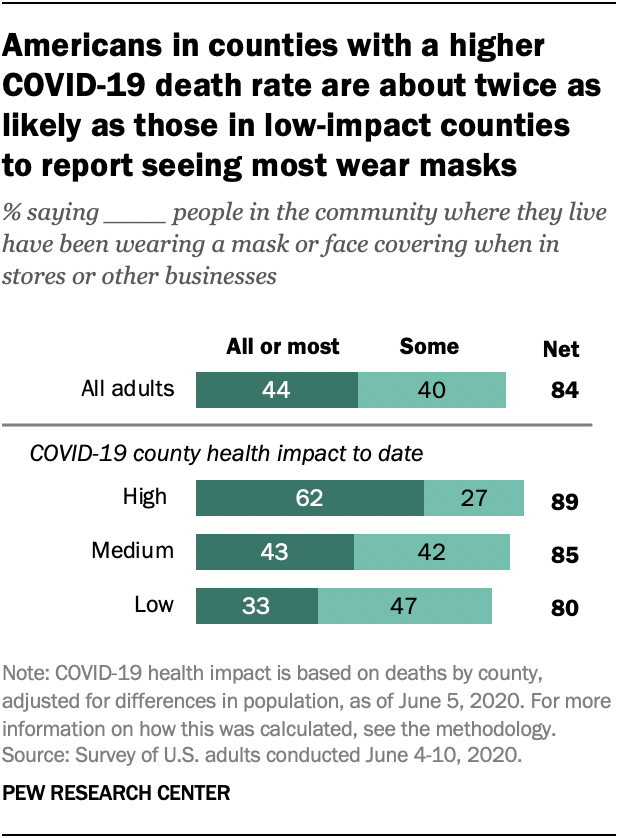
When asked more generally about mask-wearing in the communities where they live, 44% of Americans say that all or most of the people in their area have been wearing masks in stores or other businesses, 40% say that some people have been wearing masks, 11% say only a few people have been wearing masks and 1% say no one in their community has been wearing a mask.
Americans’ observations about mask-wearing behavior in the areas where they live vary by the severity of COVID-19 health impacts in the community. About six-in-ten adults (62%) who live in counties with the highest COVID-19 death rates say that all or most people in their communities are wearing masks, compared with 33% of those who live in areas that have the lowest number of coronavirus deaths per capita.
Among Americans living in counties with the highest death toll from COVID-19, those in urban and suburban communities (63% and 68%, respectively) are much more likely than those living in rural areas (43%) to say they see all or most people wearing masks.
Note: Here are the questions used for this report, along with responses, and its methodology.
